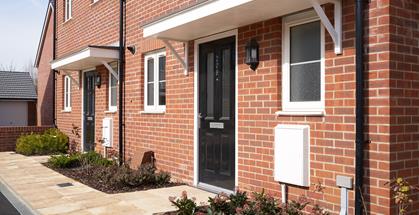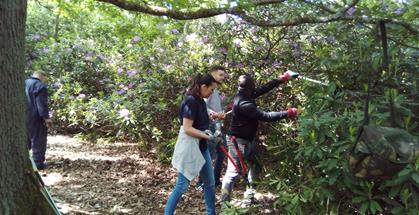2022/23 Report
Sustainability Reporting Standard for Social Housing
We are proud to deliver our second annual report on Environmental Social Governance (ESG) using the Sustainability Reporting Standard (SRS) for Social Housing as a framework.
Over the past 12 months we have seen a steady improvement in performance in several areas:
-
Contents
The Sustainbility Reporting Standard is recognised as a leading voluntary ESG sector standard that allows housing providers to measure and communicate their ESG performance in a common, consistent and transparent way. The standard reports on a matrix of 42 criteria across 12 themes (listed below)
Social
- Affordability and Security C1-C5
- Building Safety and Quality C6-C8
- Resident voice C9-C11
- Resident support C12
- Placemaking C13
Environmental
- Climate Change C14-19
- Ecology C20-C21
- Resource Management C22-C24
Governance
- Structure and Governance C25-C30
- Board and Trustees C31-C41
- Colleague Wellbeing C42-C46
- Supply Chain C47-C48
Social
Our business is built around the importance of a home as the foundation that enables individuals and families to build and sustain the lives they want.
We are focused on increasing housing availability and affordability in one of the most expensive parts of the UK and are proud to own and manage 5,780 much-needed homes for social and affordable rent, intermediate rent, leasehold, shared ownership and private market rent (through Thrive Places).
Highlights
-
C1. For properties that are subject to the rent regulation regime, report against one or more affordability metrics.
Across Thrive’s 4,419 homes for social and affordable rent our median rents are:
- 47.12% cheaper than the average Private Rental Sector (PRS)
- 55.34% lower than the Local Housing Allowance (LHA) for the local authority of operation.
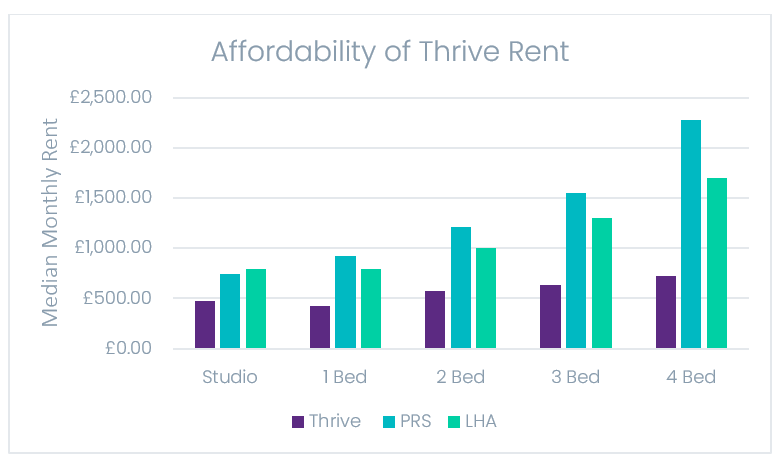
-
C2. Share and number of existing homes (owned and managed) completed before the last financial year.
At the end of March 2023, Thrive Homes either owned or managed 5,070 homes for social housing out of a total of 5,780 properties.
This figure is an increase of 10% on the previous financial year where 4,609 out of a total 5,174 homes were for social housing.
Existing March-22 % General needs, let at social rent 3,165 61.2 Intermediate rent 186 3.6 Affordable rent 382 7.4 Supported housing 0 0.0 Housing for older people 571 11.0 Low-cost home ownership 305 5.9 Care homes 0 0 Private rented sector (PRS) 61 1.2 Other (incl. leasehold, commercial and non-dwellings) 504 9.7 -
C3. Share and number of new homes (owned and managed) completed in the last financial year.
Additions March-23 % General needs, let at social rent 326 52.5 Intermediate rent 12 1.9 Affordable rent 27 4.3 Supported housing 0 0.0 Housing for older people 0 0.0 Low-cost home ownership 115 18.5 Care homes 0 0.0 Private rented sector (PRS) 0 0.0 Other (incl. leasehold, commercial and non-dwellings) 141 22.7 -
C4. How is the housing provider trying to reduce the effect of fuel poverty on its residents?
We are working to improve the energy efficiency of our homes for the benefit of our customers, our portfolio and the environment.
In order to achieve government targets for social housing, we are developing a roadmap for every home, detailing what improvement work is needed to meet energy efficiency standards so we can plan future investment.
After securing £826,000 of Wave 1 SHDF, we have installed external wall insulation in 82 homes. A further £1.5m of wave 2 funding secured in March 2023, will see another 155 homes receiving energy efficiency improvements.
To further support residents struggling with increasing energy costs, we have developed a page on our website offering information and advice about using their heating systems efficiently and ran a webinar on the subject in September 2022. In addition, we are committed to installing LED lightbulbs in every home that needs them when we visit and are trialling energy saving products such as EndoTherm®.
-
C5. What % of rental homes have at least a 3-year fixed tenancy agreement?
At the end of March 2023 7.8% of our homes (404) were on fixed-term tenancies. Thrive has made a commitment to convert any fixed-term tenancies due for renewal into lifetime assured tenancies in line with the Renters Reform Bill. This is already in progress and dependent on the customer keeping to the terms of their tenancy agreement.
Building Safety
Providing a safe home is a fundamental element of our core purpose. As such, we have carried out considerable work to prepare for the implementation of recent legislative and regulatory changes around fire and building safety.
We tightly managed the development of our first two high-rise buildings, which are within the scope of these new regulations, including additional checks to ensure the quality and safety of their construction.
Thrive is also seeking to build up an overall picture of our homes which enables us to fully understand their individual safety status, including blocks where we have and leaseholders.
-
C6. What % of homes with a gas appliance have an in-date, accredited gas safety check?
On the 31 March 2023, we were 99.92% compliant. Three homes were overdue due to access issues and legal proceedings were underway.
-
C7. What % of buildings have an in-date and compliant Fire Risk Assessment?
On 31 March 2023, we were 100% compliant across all buildings requiring a fire risk assessment.
-
C8. What % of homes meet the national housing quality standard?
As of 31 March 2023, 99.8% of our homes met the national housing quality Decent Homes Standard.
Resident Voice
As a professional landlord, we are committed to delivering a fair deal for our customers – providing them with a safe, well-maintained home and listening to what they have to say. However, we appreciate that sometimes things go wrong and are always keen to work with customers to resolve any issues.
-
C9. What arrangements are in place to enable the residents to hold management to account for the provision of services?
As part of our drive to improve knowledge and understanding of what customers think and feel, we overhauled our customer engagement model. This involved the launch in May 2022 of Thrive Customer Voice (TCV), which aims to make it as easy as possible for people to engage with us on issues that matter to them.
TCV works by using feedback and data from a range of sources to identify areas in need of review. We then reach out to customers with details of how they can take part and customers then choose if, how, and when they want to be involved. This revised approach has been a huge success, encouraging many more people to get involved and bringing us a broader cross-section of views, which is more representative of our wider customer community.
Membership has exceeded expectations, growing by just over 40% in the first year and involving almost 50% of our households, with nearly 700 customers taking part in activities including surveys and online events.
-
C10. How does the housing provider measure Resident Satisfaction and how has Resident Satisfaction changed over the past three years?
We’re proud to deliver quality services and each month we undertake three surveys with a random selection of over 150 customers to measure satisfaction, these include:
- ‘Contented Customer’ – a perception survey asking general questions about Thrive services that customers have used in the last 12-months
- ‘Repairs’ – specific questions about the quality of recent repair appointments
- ‘Lettings’ – questions about becoming a new Thrive customer.
Results are published quarterly on our website.
At the end of the 2022-23 financial year, Thrive’s level of customer satisfaction (overall) ranked 25th against 42 comparators and was 1% higher than the average benchmark from IFF Research (independent specialist in customer satisfaction data analysis).
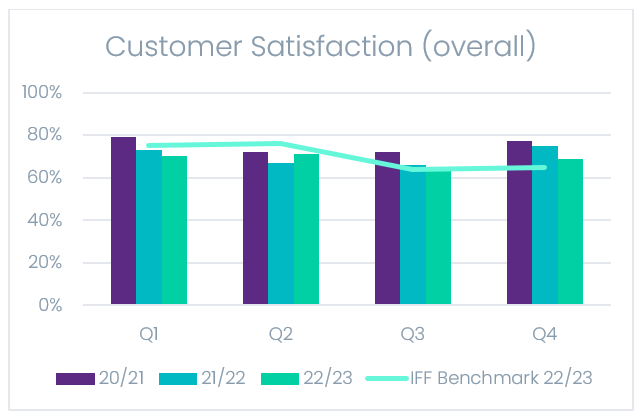
-
C11. In the last 12 months, how many complaints have been upheld by the Ombudsman? How have these complaints (or others) resulted in change of practice within the housing provider?
Reflecting a trend across the sector, Thrive Homes saw a 1% increase in complaints in 2022-23 compared with the previous year and a 48% increase in escalations. This prompted us to look at how we improve our handling of complaints and ensure they are responded to on time. This review and subsequent changes to the process have resulted in all complaints being answered on time since November 2022.
In addition, we now have two Customer Engagement and Insight Officers who provide regular training and support to help our teams respond well and resolve complaints efficiently.
Three complaints were upheld by the Housing Ombudsman, resulting in changes to our procedures and more internal audits around the defects process, handling of anti-social behaviour and contractor management.
We continually review our approaches in line with the Housing Ombudsman, and use their spotlight reports to keep abreast of best practices. All changes are communicated to customers through our website, by sharing how we have been listening and learning from their feedback.
Resident Support
Thrive’s greatest social contribution is delivered through our core purpose – providing and managing housing that helps individuals and families secure a good quality, safe home that they can afford. We also partner with organisations that provide other services to support our customers and the wider community.
-
C12. What support services does the housing provider offer to its residents. How successful are these services in improving outcomes?
Our community grant application scheme – Thrive GIVE – provides funding to locally based charities and community groups, enabling them to deliver projects and services that make a real difference to our customers.
In 2022-23 grants were awarded to nine community-based organisations. This included a significant grant to Three Rivers Citizens Advice Service who provided over 226 Thrive customers with money advice and budgeting support, an increase of 74% on the previous year (130 customers).

The gift of warmth to those who need it most
Thrive Homes has teamed up with Small Acts of Kindess to distribute 'Warm in Winter' gift bags to our most vulnerable customers.
Read more...-
C.13 Provide examples or case studies of where the housing provider has been engaged in placemaking or placeshaping activities.
Due to our position in our current development cycle, we have not been influencing placemaking or placeshaping activities in this financial year.
Environment
At Thrive Homes, we believe the key to being a resilient is by operating in a way that minimises impact on the environment and promotes positive social outcomes.
We have developed an asset roadmap with a plan for every home. This includes future investment works to ensure our housing stock is improved, to meet energy efficiency standards so it achieves EPC C by 2030 and by adopting a ‘fabric first’ approach, moving us towards net zero carbon by 2050.
Highlights
-
C14. Distribution of EPC ratings of existing homes (those completed before the last financial year).
Our closing position for this reporting year stood at 75% of our homes rated at EPC C or higher which represents a 19% increase on last year’s position.
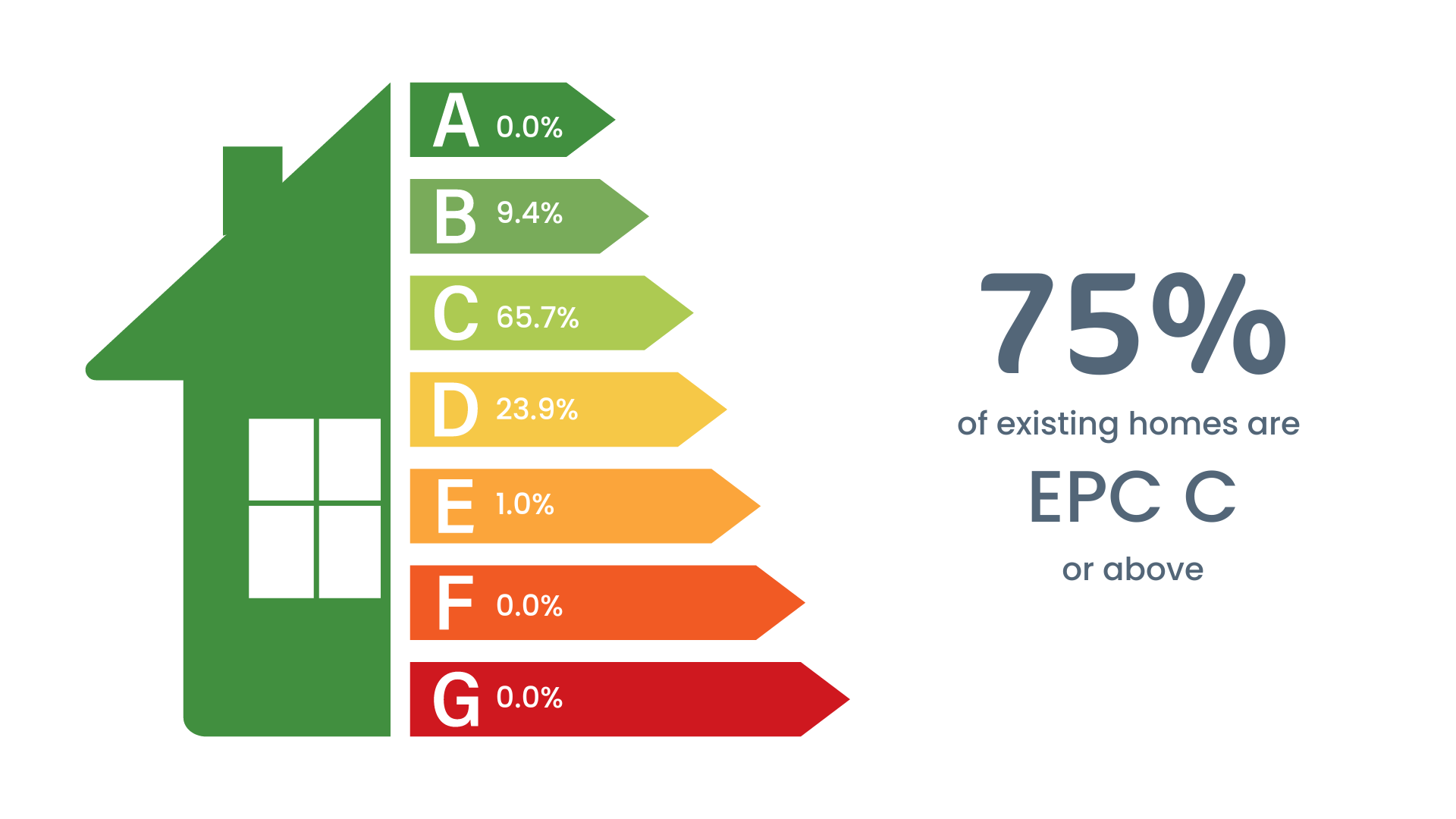
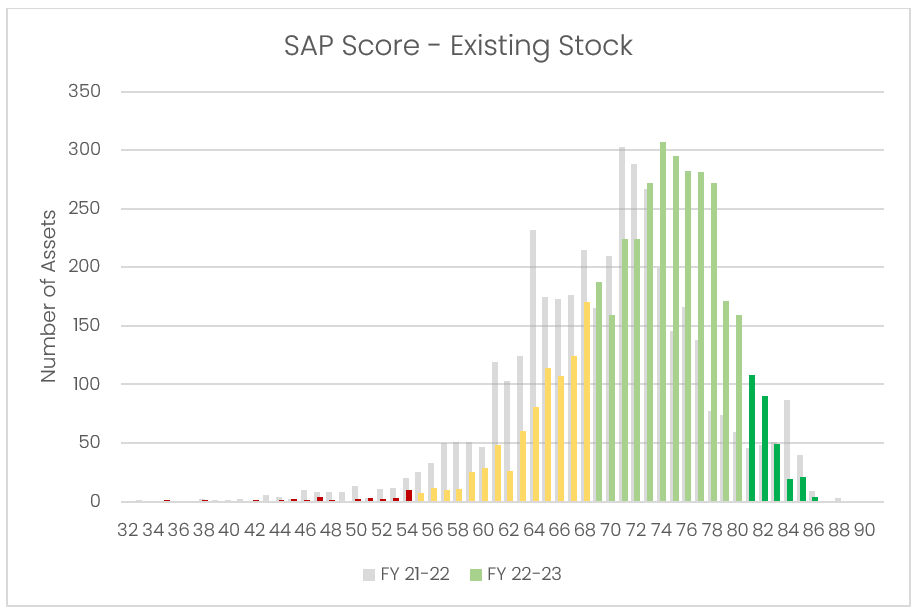
-
C15. Distribution of EPC ratings of new homes (those completed in the last financial year).
All new homes completed in the last financial year were EPC A (10%) or EPC B (90%). Of these developments, five were built to be carbon negative in their operations, making them the first Net Zero* homes in Thrive’s portfolio.
Thrive will continue to ensure all our new homes are built to a minimum energy performance rating of EPC B, building to EPC A where economically feasible.
*We stress that Net Zero here only relates to the properties ‘in-use phase’. We recognise that these developments, like all our developments, have a life cycle carbon cost.
-
C16. Scope 1, Scope 2 and Scope 3 greenhouse gas emissions.
We have categorised our emissions into three core areas: operations, development, and our existing stock. Where gaps in our data exist, we have used appropriate proxies and put in place a pathway towards obtaining the data needed for more accurate carbon accounting.
Scope 1: Kg CO2 equivalent
104,000
Scope 2: Kg CO2 equivalent
16,000
Scope 3: Kg CO2 equivalent
17,453,000
TOTAL
17,573,000
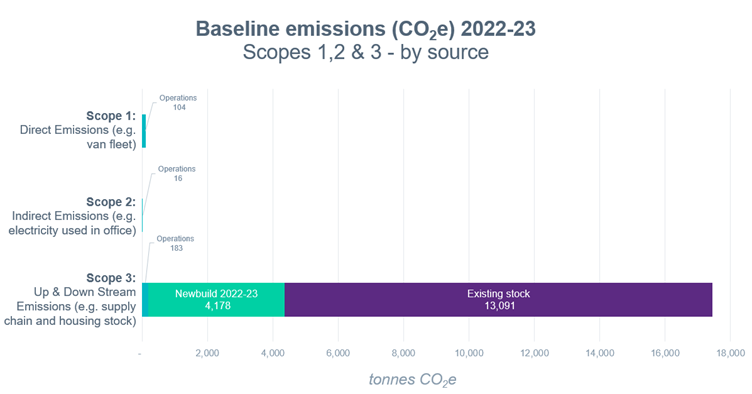
-
C17. What energy efficiency actions has the housing provider undertaken in the last 12 months?
In 2022-23, we upgraded the loft insulation in 250 homes and hundreds of customers read our advice on how to keep their home warm by using less energy.
Together with our partners, we secured over £1.5million in funding from the Social Housing Decarbonisation Fund Wave 1 and Wave 2 schemes. Work began on installing external wall insulation (EWI) to 82 homes with the Wave 1 funding and a further 131 homes were identified to receive EWI under Wave 2 in 2023-24.
Separately, a delivery plan has been established to bring a further 30 homes from EPC E to C with ECO4 funding, we have implemented intelligent energy software and completed our push to cleanse energy stock data in order to determine the performance of our homes.
Our focus remains on a fabric-first approach ensuring all customers – whether they live in a new build or not – benefit from better insulated homes that require less energy to heat.
-
C18. How is the housing provider mitigating the following climate risks; increased flood risk and increased risk of homes overheating?
Thrive has incorporated the following target into its asset sub-strategy ‘map our stocks exposure to climate change to understand climate adaptation measures required, such as; increased risk of flooding and potential for overheating.’ Targets for the following year include incorporating climate adaptation measures into wider asset management plans and retrofit designs.
-
C19. Does the housing provider give residents information about correct ventilation, heating recycling etc? Please describe how this is done.
We have a comprehensive customer advice section on our website providing information on ventilation related to preventing and/or managing damp and mould and recycling, alongside general information to help look after your home.
To support customers struggling with spiralling energy prices we launched a dedicated page on our website offering information and advice about using their heating systems most efficiently and ran a webinar on the subject in September 2022. Read more at www.thrivehomes.org.uk/money-energy-help
Ecology
As a landlord we understand the importance of green space and biodiversity for the environment, ecology and the wellbeing of our customers. Thrive’s new ESG response incorporates targets around green spaces for new and existing homes, with measures to maintain and improve these areas built into our financial planning.
-
C20. How is the housing provider increasing Green Space and promoting Biodiversity on or near homes?
Thrive’s Medium Term Plan (MTP) has identified an additional investment of £400,000 for environmental works. This will maintain the appearance of our homes to positively contribute to the local area and enhance our green spaces, promoting biodiversity where possible.
-
C21. Does the housing provider have a strategy to actively manage and reduce all pollutants?
No, but planning to develop one.
-
C22. Does the housing provider have a strategy to use or increase the use of responsibly sourced materials for all building works?
No, but planning to develop one.
Thrive has incorporated the following target into its asset sub-strategy ‘Map our resource management practices across the business and develop a strategy to drive improvement in waste, water, and material management.’ Targets for the following year will be created from this mapping exercise.
-
C23. Does the housing provider have a strategy for waste management incorporating building materials?
No, but planning to develop one.
Thrive has incorporated the following target into its asset sub-strategy ‘Map our resource management practices across the business and develop a strategy to drive improvement in waste, water, and material management.’ Targets for the following year will be created from this mapping exercise.
-
C24. Does the housing provider have a strategy for good water management?
No, but planning to develop one.
Thrive has incorporated the following target into its asset sub-strategy ‘Map our resource management practices across the business and develop a strategy to drive improvement in waste, water, and material management.’ Targets for the following year will be created from this mapping exercise.
Governance
At Thrive, we pride ourselves on an innovative approach to challenges and the ability to adapt to the fast-changing environment in which our sector operates. Our culture, governance, and approach to managing risk are central to our success and resilience as a business.
Highlights
-
C25. Is the housing provider registered with the national regulatory of social housing?
Yes
-
C26. What is the most recent regulatory grading/status?
The Regulator of Social Housing (RSH) published the results of their In-Depth Assessment (IDA) in April 2023. The results were that Thrive was assessed to retain the highest level possible for Governance (G1) and, reflecting the current economic climate, Viability (V2).
-
C27. Which Code of Governance does the housing provider follow, if any?
Thrive Homes continues to comply with the NHF Code of Governance 2020. Compliance is reviewed annually with an internal self-assessment which is reviewed by the Customer, Colleague and Governance Committee and approved by Board.
Additionally, Thrive has adopted the 2020 NHF Model Rules for registered providers and is a signatory to the NHF Together with Tenants Charter which forms part of Board’s commitment to ensuring that the voice of the customer is heard and informs decision making. We are also compliant with the Housing Ombudsman’s Complaint Handling Code.
-
C28. Is the housing provider not-for-profit? If not, who I the largest shareholder, what is their % of economic ownership and what % of voting rights do they control?
Yes, Thrive Homes is a registered not-for-profit provider of affordable homes.
-
C29. Explain how the housing provider’s board manages organisational risks.
To maintain our strength, resilience and agility as a business, we are very conscious of the need to take an astute and proactive approach to balancing risk in the short, medium and long-term. Constantly monitoring and managing such risks ensures that Thrive is able to rise successfully to today’s challenges while being well-prepared for the potential challenges of the future.
Thrive has programmes of internal audit to sustain and improve the quality of our day-to-day business operations, along with mitigation strategies which flag up risks at the earliest opportunity so we can take appropriate steps to address them.
In addition, the Board identifies the changing risks to our business, along with the various external and internal factors influencing their management. These risks are regularly reviewed by the Risk & Audit Committee, which then reports back to the Board on its findings.
-
C30. Has the housing provider been subject to any adverse regulatory findings in the last 12 months (data protection breaches etc) – that resulted in enforcements or other equivalent action?
No.
-
C31. What are the demographics of the board? And how does this compare to the demographics of the housing provider’s residents?
Membership of the Board is based on an evaluation of skills and experience and is made up entirely of non-executive members.
Board Customer Gender balance 36% Female
64% Male53.03% Female
46.84% Male
0.13% TransgenderAverage age 53 51 % with a disability 0% 10% BME profile 9% BME
91% White
4.77% BME
43.46% White
51.77% No info
Average tenure 3.14 years n/a Turnover in last 2 years 25% n/a -
C32. What % of the board and management team have turned over in the last two years?
Since the start of the 2022-23 financial year, we have seen a 25% turnover of board members and 20% turnover within the Executive Management Team.
Board membership is reviewed on a regular basis with a skills audit identifying gaps for future recruitment and/or training.
-
C33. Is there a maximum tenure for a board member? If so, what is it?
Yes, the maximum tenure for a board member is six years, with an option to extend for another three years in exceptional circumstances.
-
C34. What % of the board are non-executive directors?
100%
-
C35. Number of board members on the Audit Committee with recent and relevant financial experience.
All six board members on Thrive’s Risk and Audit Committee have recent and relevant financial experience.
-
C36. Are there any current executives on the Renumeration Committee?
All members of the Executive Management Team (five in total) sit as non-voting Executive Directors on the Renumeration Committee, referred to as Customer, Colleague & Governance Committee within Thrive Homes.
-
C37. Has a succession plan been provided to the board in the last 12 months?
Yes, we provide an annual report to Board on succession planning, which is completed following an in-depth evaluation of skills and experience.
-
C38. For how many years has the housing provider’s current external audit partner been responsible for auditing the accounts?
Independent auditors, Beevers and Struthers have been responsible for auditing the accounts for the past four years and have expressed their willingness to continue in office.
-
C39. When was the last independently-run, board-effectiveness review?
Thrive undertakes an independent Board-Effectiveness Review every three years. The next is due to be presented to Board in September.
-
C40. Are the roles of chair of the board and CEO held by two different people?
Yes. You can view the full list of board and executive team members here.
-
C41. How does the housing provider handle conflicts of interest at the board?
Board members are asked to declare any conflicts of interest at every meeting with declarations updated every six months and published on Thrive's website.
Colleague Wellbeing
In a tough operating environment, along with the ongoing cost-of-living crisis, Thrive appreciates the need to ensure all colleagues feel supported to cope with the challenges they face.
We want colleagues to feel comfortable, fulfilled, valued and listened to at work. Our Wellbeing Commitment has various strands, outlining what we offer in terms of colleagues’ safety, physical and mental health, and financial wellbeing.
-
C42. Does the housing provider pay the Real Living Wage?
Yes
-
C43. What is the median gender pay gap?
Thrive’s median gender pay gap is currently sitting at 10%.
This figure is influenced by the disproportionate number of female colleagues (28) in the lowest pay quartile to males (8) and is the only quartile where we see this trend as all other areas have a good gender balance.
Thrive is working hard to ensure entry-level roles within the business attract applicants from all genders and is actively ensuring that roles are advertised using gender-neutral language and imagery to avoid bias.
-
C44. What is the CEO:median-worker pay ratio?
Thrive Homes is not reporting the CEO:median-worker pay ratio at this stage but it is something we plan to do in the future.
-
C45. How does the housing provider support the physical and mental health of their staff?
Health and wellbeing is central to all we do at Thrive. We understand that our colleagues are our greatest assets, and we want to do everything we can to maintain their physical, mental and financial wellbeing. Since the introduction of our Wellbeing Commitment in 2020, we have seen an increase in training and health related benefits available to colleagues including the introduction of YuLife providing incentives for movement and mindfulness, alongside financial advice from our pension provider.
Colleagues are surveyed regularly, with questions about our offer as well as temperature checks on their physical, mental and financial health. Using feedback from these surveys, as well suggestions from our intranet and internal meetings, we evaluate the successes and make changes based on real, measured feedback.
-
C46. What is the average number of sick days (both long and short term) taken per employee?
Thrive’s average number of sick days per colleague in the 2022-23 financial year was 0.7 days.
Since the launch of Thrive’s Wellbeing Commitment in 2020, we have seen a significant reduction of absence across the business including a drop in the proportion of absences related to mental health issues, due to better training, understanding and intervention.
-
C47. How is Social Value creation considered when procuring goods and services?
Thrive has a procurement policy, which sets out our approach to social value creation. Social value has been replaced with ESG based on future Net Zero strategy. This is considered at all stages in the procurement cycle from the business case considering what opportunities could be available for relevant contracts, through to the quality questions in the ITT (weighted at least 10%), evaluation of the benefits, contractualising the tender promises and finally monitoring progress.
-
C48. How is the Environmental impact considered when procuring goods and services?
Thrive has a Procurement policy which sets out our approach to environmental improvements based on future Net Zero strategy. This is considered at all stages in the procurement cycle from the business case considering what opportunities could be available for relevant contracts, through to the quality questions in the ITT (weighted at least 10%), evaluation of the benefits, contractualising the tender promises and finally monitoring progress.


